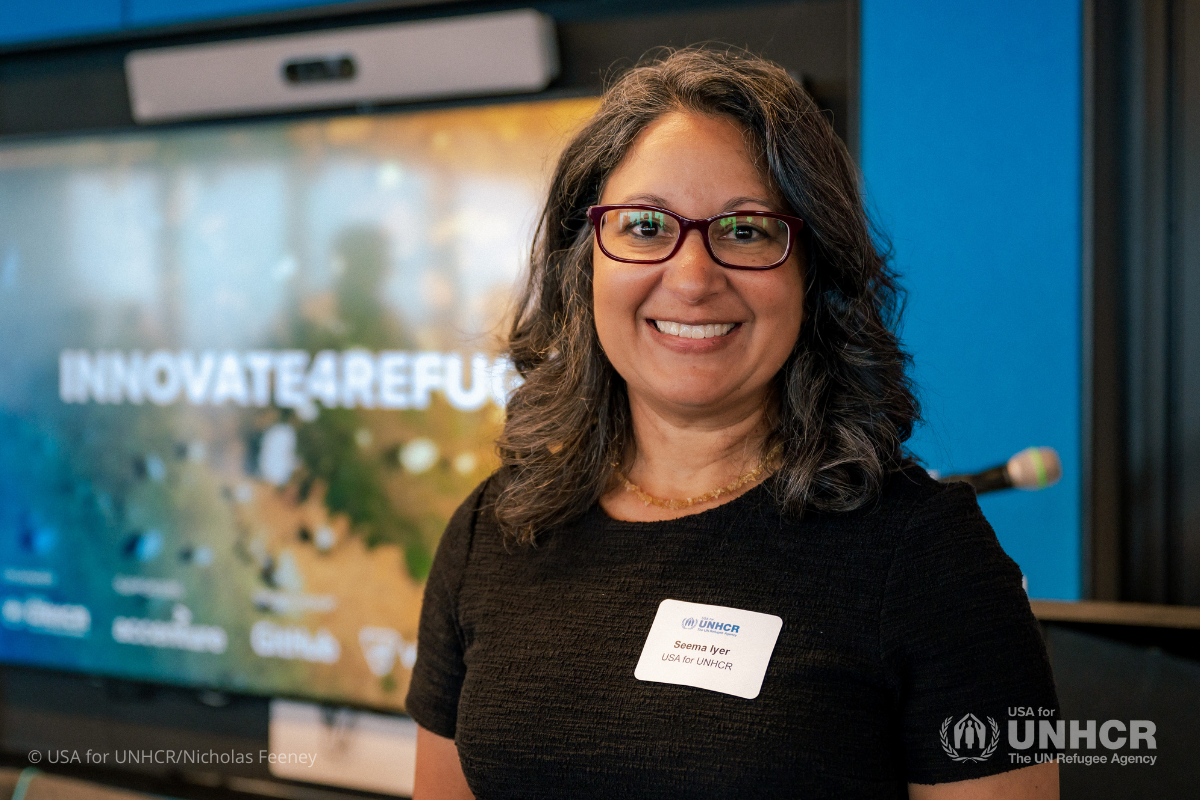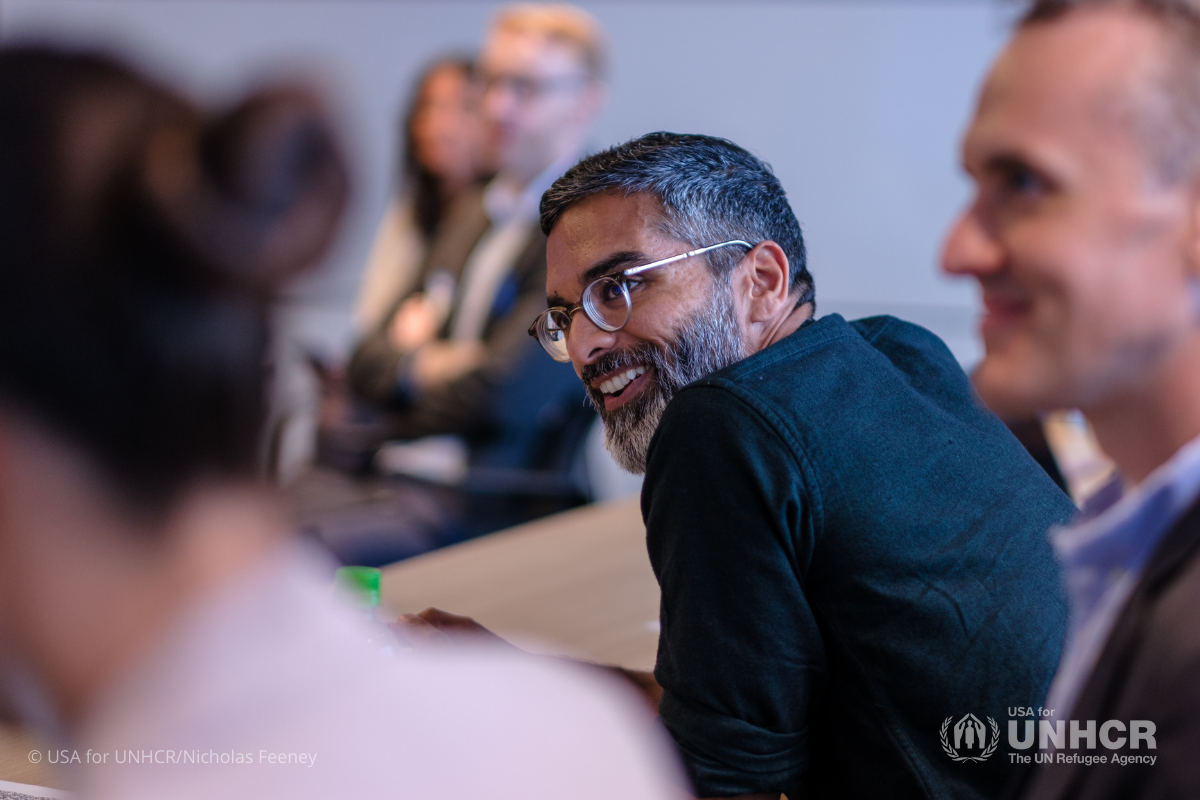Behind the Scenes: Innovation at the Hive
Nicole Smith serves as Senior Manager of Tech Initiatives and Partnerships for The Hive, a data science innovation lab at USA for UNHCR, the UN Refugee Agency. The Hive’s mission is to raise awareness and drive engagement with the public to ensure data science and emerging technologies are a critical part of the solution for addressing the needs of refugees. For more than 5 years, Nicole has worked to create pathways for individuals and organizations who want to help refugees through tech-based skills and resources and believes that centering refugees in the innovation process is the key to successful integration and adoption.
According to the 2023 UNHCR Global Trends Report, 120 million people have been forcibly displaced worldwide. In my six years at USA for UNHCR, the number of people fleeing violence, persecution and war has nearly doubled. Solutions to address the root causes of forced displacement remain elusive. Despite that, we must commit to developing solutions that assist and empower refugees on all steps of their journey.
The Hive is the innovation lab at USA for UNHCR, utilizing data science and emerging technologies to design outcomes for refugees. As The Hive approaches ten years of serving the refugee-supporting ecosystem, I want to share its innovation methodology and a few lessons learned along the way.
I’m not the first to write about how the innovation process is a way to create novel solutions, with some notable examples from Harvard Business Review and McKinsey. The steps typically follow this cycle: ideate, prioritize, refine and test, iterate. Often, the main lesson of innovation can be summarized in Maslow’s adage, “If the only tool you have is a hammer, it is tempting to treat everything as if it were a nail,” discouraging folks from using the same solution to a variety of problems, regardless of fit or context. But this is not the only lesson to be learned from innovation failures (as outlined here, here and here), and the steps typically outlined overlook a key player: the end user.
Although The Hive team follows a similar innovation process, we deviate from the traditional approach by including the voices of the end user or user advocate; for our work, this includes refugees and those working to support refugees. Following a human-centered design process makes us better at our jobs. (We’re not the only ones doing this type of work -- check out the work at UNDP and COIL).
The Hive innovation process can be summarized in the following steps.
1. Design with people
Although it can be much more efficient to ideate problems in a large conference room or virtual Zoom room with folks who are investing in the solution, this first step is the most critical step to successful and sustainable innovation.
The Hive employs user research methods, such as surveys, focus groups and interviews, to learn from refugees and refugee supporters. Although collecting information can be time consuming, there is still value in smaller samples. Because challenges are constantly present throughout the refugee journey, we don’t need copious data before deciding whether an intervention is necessary. Refugees are qualified to speak about their lived experience and the skills they’ve acquired along the way.

I wrote about my experience meeting refugees in Kenya’s Kakuma refugee camp in 2019, and I often think about Bahana Hydrogene imploring us and other nongovernmental organizations to “Work with [refugees], not for [refugees].” By honing The Hive’s approach to human-centered design, we can include those with lived experience in forced displacement in the overall innovation process and better understand the issues they face daily.
2. Synthesize and identify problems
After gathering feedback and data points from refugees and other relevant stakeholders, we often confirm the problems via research and literature reviews and look for themes. By zooming out from the minutiae, we often find that issues are common among refugees even when expressed in various ways at different points of the refugee experience.
3. Brainstorm solutions with relevant stakeholders, including user advocates
The Hive team presents problems and often rough solutions to the user advocates, allowing us to confirm that we correctly interpreted the problems and that the solutions identified will support the community in need. I’ve previously written about The Hive’s approach to reciprocal partnerships in data science here.
4. Incubate and further scope solutions - we often iterate on this step
The Hive has the skills and leeway to test solutions developed in our innovation process, and we find that the most successful interventions are often tested and rescoped before final deployment. For example, The Hive worked with UNHCR’s Division of International Protection on a natural language processing prototype to assist with case law citations and detections, which help individuals in their asylum claims. This prototype has gone through additional scoping, particularly with the advent and penetration of generative AI.
5. Look for partnerships and collaborations with government, academia and the private sector
Some things aren’t solvable by our small and nimble team, and we look to the broader “for good” space to find partnerships willing to share resources, including grants or in-kind support, to achieve the identified solutions. When we collaborate with folks at the final step of the innovation process, we continue to follow a human-centered approach and hear viewpoints and experiences in implementing a particular solution. Because we’ve gone through a rigorous process of needs-based innovation, we can look for mutually beneficial partnerships to implement solutions.
To illustrate the importance of designing with user advocates, I want to share an innovative project that was just getting started when I joined The Hive team in 2018. The Hive participated in a hackathon with 92Y in Seattle and asked participants what technologies could be used to improve the lives of refugees. From this hackathon, the Hive embarked on a mapping project of the Dzaleka refugee camp in Malawi using satellite imagery and machine learning. This process followed the traditional innovation process, as the Hive partnered with Maxar and Stanford AI & Sustainability Lab but failed to include user advocates. The outcome of this collaboration resulted in a map, but it was ineffective and not adopted by the practitioners.

In 2020, when The Hive team embarked on another research gathering process, we heard directly from camp managers in the Kakuma refugee camp and Kalobeyei settlement in Kenya that they needed base layer maps. Although the innovation process was quite similar to our first attempt at implementing an algorithm to detect camp structures, the missing piece in the first project was buy-in from local stakeholders. Involving user advocates and those with lived experience from the beginning resulted in the successful deployment of the algorithm, notably in partnership with Microsoft AI for Humanitarian Action and Humanitarian OpenStreetMaps. This project will be showcased at The Hive’s Innovate4Refugees event in September.
Because The Hive is doing the initial legwork via focus groups and interviews with refugees and the refugee-serving ecosystem, we are better positioned to identify themes and problems. But we can’t do this work alone.
If you’re interested in partnering with Hive, please reach out at hive@unrefugees.org or subscribe to our newsletter for updates.


